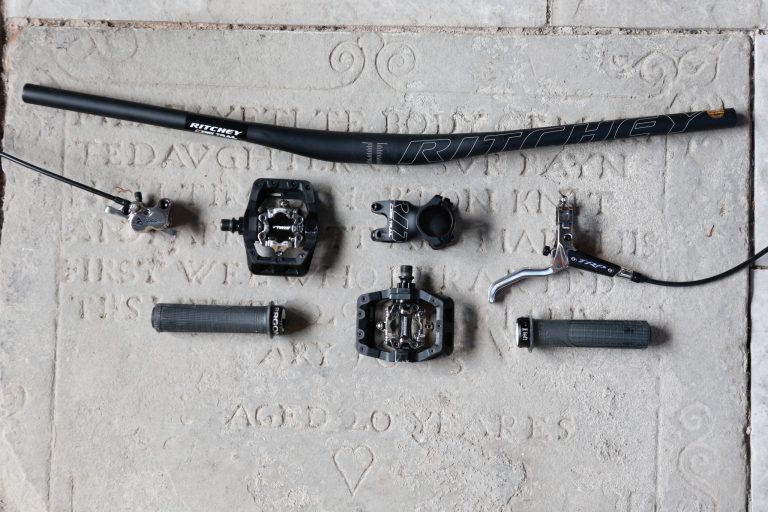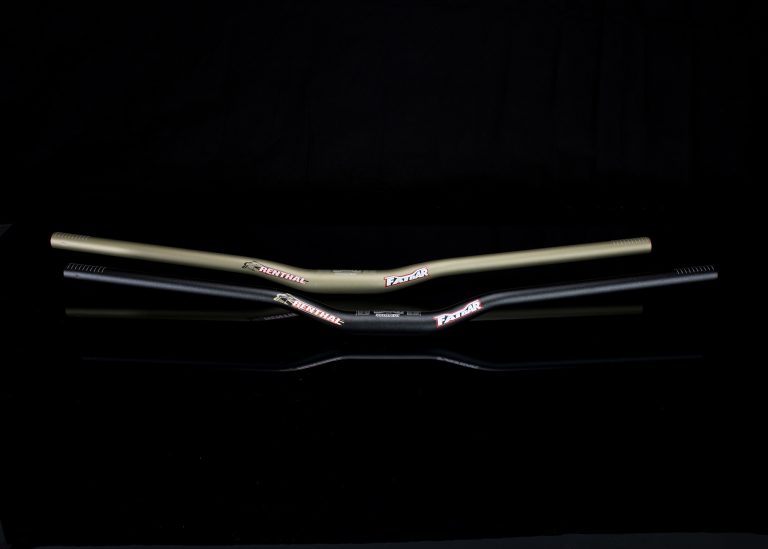
PARTLY LUCK, BUT MOSTLY JUDGEMENT
THE MEN AT GARY FISHER/TREK IN MADISON DON’T JUST WANT TO MAKE BIKES, THEY WANT TO MAKE THE BEST BIKES. IT’S GENERALLY ACCEPTED THAT THIS IS SOMETHING THEY HAVE ALREADY DONE WITH THE SESSION 88 AND IN THAT BIKE THEY CAN BACK UP THE BOLD STATEMENTS FILTERING OUT OF THE WISCONSIN KITCHEN AND REMINDED OF ‘ON THE COFFEE TABLE’ FLYERS. BUT JUST AS CORPORATE BRINGS STRENGTH IT ALSO FIRES THE INTERNET FORUMS WITH CHEAP SHOTS – JUST LIKE ANYONE ON TOP OF THEIR GAME, PEOPLE WILL WANT TO GUN YOU DOWN.
Yet I was reminded recently how much a company can create a following based on solid product. Scotland’s best, in downhill at least, are still predominantly Orange mounted; yet a certain Ben Hall is doing some serious damage to the opposition on the Session. Now I’m not for one minute saying a syndicate is emerging up there, but a wider Scottish clan, and great riders at that, seem to be increasingly Trek mounted – the country’s current fastest trail/cross country rider Andy Barlow is firing the Trek Fuel and so too his colleague and infamous UCI man Chris Ball. Crawford Carrick Anderson, probably the greatest Scottish racer ever, is meanwhile gearing up for an assault on the Mega on his six-inch Remedy.
Trail riding has become one of the biggest and most important sectors of the mountainbike market, both here and worldwide, not surprisingly what is the best tool for the job is a hot subject. Add to this increasing and varied types of enduro types of event has meant that the 140–160mm bikes now need to be complete all-rounders more than ever, good angles to underpin bold attacks on the increasingly fierce descents of our trail centres and local threads. Super fast downhill riders are turning to staged downhill races for many reasons. Time on the bike being one. And where does the Roscoe sit in amongst all this? Well it has already stirred a lot of folk with its all–round ability, baffled the number crunchers with its offset trail fork rake and generally turned heads with the air shock with a little bit extra. Here in Monmouth, once a staunch Marin foothold, might have changed its ways, but overall there is still a monumental amount of hot air drifting around regarding the best tool ‘to go riding’.
Just as we are experiencing the cyclical highs and lows, whose weather patterns make no sense to anyone who expects the steady burn of the sun at this time of year, so to the local banter on bikes continues to baffle. And upset. For trail riding locally, high rise gold bars are on the up so to speak, so too are slow rolling high volume tyres, many still don the full body armour for a mid week ride and a huge majority still deal with the bang and clatter of a triple chainset. Spinning granny is a trend that doesn’t seem to be dying even though it’s quicker walking and giving your arse a right working–over on climbs.
Still sat down remains suspectly popular given the advantages of standing on your descending strength. Most of all, the greatest card dealer of upset centre of gravity ever – the long stem – has yet to be recognised as the most evil of all stability busters. Set in their ways doesn’t even begin to describe this lot around here, so when Gary showed up most of them were bound to be guarded.

ROSCOE 2 – SEARCH FOR OBJECTIVITY
Trying to be objective in mountainbiking is an incredibly messy business. Even in a sport like downhill where the aim is to be as fast as possible from top to bottom is affected by fashion marketing. In this sense cross–country racing is possibly truer to the objectives of racing. Imagine how difficult it is then in the world of “just riding”. But whilst riding
inappropriate rigs doesn’t seem to affect the smiles on people’s faces, surely the simple fact is that in a trail bike we all want a fast light bike that can climb and descend equally well for the terrain in which we ride.
Our objective is simple in a way – to bring the cream of these trail bikes into the magazine. But returning to the luck and judgement
comment for a moment; I’m lucky in that this bike fits me absolutely perfectly. If there was ever a made to measure bike that I’ve ridden then this is it. With a 50mm stem fitted to the best bar available for all round use – the RL – the new Roscoe feels good. The componentry spec is without any weakness too and from experience know it to be of good lasting quality. Weight wise the Roscoe is up there as one of the lightweight 140mm bikes at 28lb. Fisher have certainly made some good calls, the Roscoe has some other key features, notably the E2 tapered steerer and ABP (Active Braking Pivot) which are all tried, tested and recognised.
The Roscoe also comes with new G2 fork and Fox DRCV (Dual Rate Control Valve). G2 is basically an increased off set in the fork. Whilst motorcycle engineers have spent much time in this department altering the trail is not often altered these days in mass fork sales. DRCV meanwhile is a position sensitive valve internally which only opens the secondary chamber at around 38% of the travel, providing what Fisher describe as coil like performance.

TRAIL RIDING
UP. Out on the trail the Roscoe covers ground exceptionally efficiently, a combination of cockpit and shock/linkage means that this bike climbs better than any other 140mm bike out there. It wastes little energy. Even with the short stem there is good legroom for the arse spinners and when you get into stand and attack mode you know that the leverage forces are being channelled into forward motion without wastage.
It’s great even without Pro Pedal. ACROSS. We had issues here that took several days of testing to overcome. The Fox DRCV, when set as instructed, did everything it said, providing that seamless transition between the two chambers and giving slightly better performance than the standard air can. Fisher are very clear in marketing this bike as a long travel bike that can be used for cross– country, they are also clear on settings. This is meant to cover a range of riders who prefer a subsequent range of geometries and handling characteristics. But call me old fashioned if you will, but ‘the moments’ are when the terrain levels or dips down, what else is a 140mm bike for? For this type of abuse the Roscoe has the super strong chassis to take anything in its path yet the recommended sag settings didn’t seem to leading up to a fast ride.
At 25 and 35% sag settings it was difficult to get a feel for where the bike was at when trying to pump the hill or push into and though corners, almost impossible to use full travel and difficult to understand the midstroke range. Attacks down or across were being hindered to a degree. After a load of runs on different settings I dropped the sag past the recommended amount and after finding greatly increased performance got on the blower to Gary Fisher’s chief engineer Jose Gonzales. Obviously this long travel cross–country bike was possibly being used in a manner slightly different to that intended.
Aware that dirty Welsh trail poise is slightly different than California uphill work–outs in the sun, I just wanted to get the all–clear. Anyhow, Jose gave us the OK to run the sag to an amount outside the recommended range, but he pointed out that it was within the tolerances. Away we went, even dropping onto some 2.1 Maxxis Medusa tyres, and have not looked back. The Roscoe was now tearing the living daylights out of all ahead of it, so much so that we had to call in a comparison to the widely recognised king of the trail, the Orange Five.

DEEPER AND DOWN
Rear setting was now at 40% (about 23mm, 66º head angle) and what a difference this made. High speed cornering – awesome, in fact all cornering is now predictable and feels super fast, you can load the system, weight the bike evenly and pull out easily. The bike can be picked up and its fun to ride. High speed descending is nothing less than excellent for a bike of this nature (great wheelbase) and general handling is arguably one of the best on any 140 bike. With the lower set up both wheels are weighted evenly and the ride very different to the recommended. It’ll now bottom out under the heavier hits as its supposed to, so for most UK trail riding it’s fine and the changes enabled it to use more of the terrain. The pressure settings definitely add up to a better overall dynamic geometry.
We now had a better bottom bracket height and wheelbase from which to start. There has been talk of the fork’s trail adjustment having a negative effect on the steering, but as set this bike has a balanced stable riding position with equal tyre contact, it’s very straightforward – I mean there’s no way we’d be racing mini downhill tracks on a twitchy bike, lets make that clear. I’m glad we put in the time to make the Roscoe right for what’s mostly ridden around here. Yes it’s easy to understand what the base settings and DRCV is doing and sets out to achieve, and this will probably be fine for many riders, it’s just that others might want to coax a bit more out of Gary.

OBJECTIONS
The Roscoe stands as direct challenge to the Orange Five. The Fisher climbs better, you get more for your money, but is slightly more difficult to understand. For example the Fisher benefits from more rearward biased braking. The highly refined single pivot Orange does all the basics extremely well, but when you take into consideration all the variables of price, componentry and the type of riding you do, then I’m sure many riders will feel these two 140mm bikes to be neck and neck. As clever as it is the DRCV is not comparable to a coil Cane Creek, it is nonetheless a step in the right direction, and whether the superb ride we encountered is ultimately down to ‘G2 Handling’ is also a matter that is probably being discussed in pubs up and down the country right now. Many might think that tyre choice is the all–important factor in the handling of the Roscoe. Not exactly getting very far with objectivity here am I? I’m running out of space…Fisher says this is one of the best bikes they’ve ever built. I think it could stand as one of the best trail bikes ever made. z
Price: £2500, Contact:www.fisherbikes.com.





